Freemasonic Symbolism and Georgian
Gardens
by
Patrizia Granziera
The landscape garden was conceived in England between 1710 and 1730—that is,
during the period of the European Enlightenment, which coincides with the
diffusion of Freemasonry in England and Europe. Many landlords and intellectuals
of the eighteenth century were freemasons. Among them were famous people like
Alexander Pope, Arbuthnot, Edward Harley, the Earl of Chesterfield, James
Addison, Richard Steele, Jonathan Swift, James Thomson, Lord Burlington, Lord
Cobham, William Stuckley, Lord Montague, Voltaire, Montesquieu. It is in fact at
this point in its history that Freemasonry develops as a focus for
intellectuals, politicians, the gentry, artists and architects, thus fostering a
continuous exchange of ideas, aesthetic values and beliefs between English and
European intellectuals. Freemasons believed in virtue, progress, equality, and
they contributed to the preparation of the soil for the late eighteenth century
democratic revolutions. These Enlightenment ideals (tolerance, equality,
universalism, civic duty, natural religion, morality) which they helped
propagate through their international links were also reflected - by means of
its iconography and design—in the early "emblematic" landscape garden
(1). Once
we understand the important role that Freemasonry had in the eighteenth century
and we consider that those intellectuals who belonged or had links with this
secret society were also responsible for the developments in the arts -
landscape architecture included—we cannot but agree that it is important to
research the relation between Freemasonry and the early English landscape
garden. But we should begin with an introduction on the history of Freemasonry
and its role in the eighteenth century.
Freemasonic history
Modern English Freemasonry came to be publicly known at a meeting of four
London lodges on St. John's Day (June 24) 1717, when it was decided to found a
new speculative Freemasonry (2). It is at this point that Freemasonry became a
focus for intellectuals, politicians, the gentry, artists and architects.
Freemasonry, with its mystical overtones and origins dating back to the Middle
Ages, held a fascination for the cognoscenti. Medieval stonemasons were called
"freemasons" since they were not bound to a guild in any specific city but were
forced to wander from place to place where churches were erected. It was through
this that the movement acquired the character of an international society. The
first masonic manuscripts, the "Old Charges" (3), explain the nature of the
connections of the Craft with myth, Antiquity and a moral system of conduct
(4).
Two common elements of these works on Masonic history are the reference to God
as «Great Architect of the Universe» and the definition of the seven liberal
arts (Grammar, Dialectic, Rhetoric, Arithmetic, Astronomy, Harmony and Geometry)
with a particular stress upon Geometry, which was considered to be the source of
Knowledge, an art which had the potential to re-create the Divine in building,
the lost Temple of Solomon itself (5). According to legend, the Temple of
Solomon in Jerusalem was built by Hiram, who knew some architectural secrets
unknown to all others, but was murdered by three apprentices. The initiation
ceremony for the master mason grade commemorates this event
(6).
For freemasons the Solomonic Temple was an example of divine architecture.
Vitruvian ideas and Classical Architecture derived from this structure, and the
three orders (Corinthian, Doric, Ionic) of the Temple were brought to Greece and
the West by Pythagoras. According to the legend, after the flood Pythagoras
found the two pillars on which the secrets of Geometry were inscribed and he,
together with the great geometer Hermes Trismegistus, told these secrets to the
Greeks. These pillars, among others, were set up by Solomon to build his temple.
The right-hand column was called Joachin and it was associated with
establishment and legality; the left-hand column was called Boaz and symbolized
strength (7). Thus the idea of Geometry, the root of Masonry, as an exclusive
and secret art and science handed down from the deities to an élite of people,
originated from these legends, which in the eighteenth century became
influential in shaping the characteristic masonic self-conscious mythology
embedded in ritual..
However, the Rosicrucian movement also played an important role in bringing
Hermetic and esoteric Renaissance traditions into Freemasonry. Rosicrucianism
was named after Christian Rosenkreutz, the principal mythical character of two
manifestos which were published in Kassel in 1614-1615, written by an anonymous
author. The "Fama" and the "Confessio" told the story of Rosenkreutz, an
enlightened man who travelled, mainly in the Orient (8). He founded the
«bretheren of the Rosie Crosse» an association of learned men who were charged
to exchange their knowledge, to heal the sick free of charge and to proclaim
that the time was at hand for a great advance in the knowledge of nature
(9).
This reformation of the world, however, was not only based on Evangelic
Christianity with its emphasis on brotherly love, but also on Western esoteric
traditions.
The link between this esoteric Hermetic movement and the first system of
lodges which emerged in Scotland around 1600 appears even more evident when we
consider that the masons had long possessed a tradition, enshrined in the Old
Charges, that Hermes had played a major part in preserving the knowledge of the
mason's craft and transmitting it to mankind after the flood and that the key
development in craft history, the teaching of masonry by Euclid, had taken place
in Egypt. Rosicrucianism therefore influenced the early development of
Freemasonry, adding to the already mixed masonic lore ( the myth of Egypt,
Solomon's Temple, The Hermetic quest), the myth of the secret order of invisible
brethren, dedicated to the search of ultimate truths and to the understanding of
the mysterious universe (10).
Moreover, emerging Freemasonry was also influenced by the Renaissance concept
of the architect (11). In the fifteenth and sixteenth century, the architect
came to occupy a remarkably exalted position in Renaissance thought. The Vitruvian concept of the architect and the techniques and styles of architecture
detailed by Vitruvius were held not only to be relevant to the education of
architects but to be essential elements in the education of a gentleman. In
Vitruvius's main work The Ten Books of Architecture (first translated
into English in the eighteenth century), the architect is seen as the master of
all the arts central to human knowledge, including the mathematical arts, thus
becoming the Renaissance ideal, the Universal Man (12). The great Stuart
architect Inigo Jones, who first made the English public acquainted with
Palladian principles of proportion and design, was thought to possess the
Vitruvian pretensions of the architect (13). In 1624, in a satire, Ben Jonson
wrote about him :
He has Nature in a pot! 'boue all the Chemists,
Or bare-breeched brethern
of the Rosie-Crosse!
He is an Architect, an Inginer,
A Souldier, a
Physitian, a Philosopher,
A general Mathematician.....
(14)
Thus, since the seventeenth century, the comprehensible world of the
Vitruvian architect and mathematician and the occult and mystical world of the
followers of Hermes Trismegistus and Christian Rosencreutz became two important
elements of the freemasonic thought.
Freemasonic philosophy
It was only in 1717 when Modern English Freemasonry was finally organized
under the Grand Lodge of London, formed by the union of four London lodges, that
the philosophical symbolism was officially recognized and with it the moral
significance of the tools and methods used in the building trade. Utensils such
as the square stood for righteousness, justice and virtue and the compass
circumscribed moral behaviour and served as a measurement for harnessing the
passions: " keep within the compass and you will be sure to avoid many dangers
which others endure (15)." The level symbolized equality, the plumb rule and
uprightness, the trowel for " spreading the cement of brotherly love
(16)." The unhewn stone, or rough ashlar, that is part of the furniture of every Masonic
lodge, is said to represent "man in his infant or primitive state, rough and
unpolished", the polished stone or perfect ashlar represented man "in the
decline of years, after a regular well spent life in acts of piety and virtue
(17)." (Fig. 1)
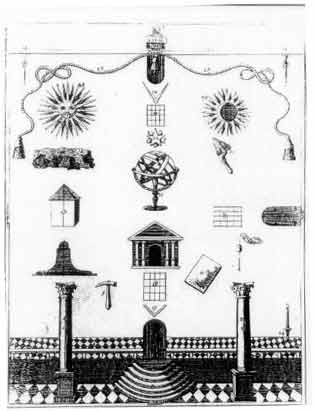 |
True Plan of a Lodge for the Reception of an Apprentice,
showing the Masonic emblems :
(1,2) Joachin and Boaz
(3) the steps to
the Temple;
(4) the Mosaic Pavement;
(5) the western gate;
(6) the gate to the
interior chambers;
(7) the southern gate;
(8) the eastern gate;
(9) the
hammer;
(10) the trowel;
(11) the tracing board;
(12) the uncut stone;
(13)
the cubic stone with pyramid;
(14) the compasses;
(15) the plumb;
(16) the
level;
(17) the square;
(18,19,20) the western, southern and eastern lights;
(21) the globe;
(22) the flaming star;
(23) the houpe dentelée;
(24) the three
lights;
(25) the seat of the Grand Master;
(26) the altar;
(27) the stool;
(28) the sun;
(29); the moon. United Grand Lodge of England (UGLE),
London. |
The aristocratic and middle-class fraternity of the eighteenth century still
talked of building "Solomon's Temple" which represented perfected man. It was
the task of Freemasonry, of its "apprentices", "companions" and "masters" to
reconstruct the original proportions of this "moral edifice" and the procedures
of building were often used to illustrate the process of spiritual development
(18). Those men who joined the Craft belonged to a variety of ranks and
religious beliefs, tradesmen, gentlemen, doctors, merchants, Christians, heterodoxists, anticlericals. Many reasons might have motivated these people to
become masons. One was the simple social life and conviviality of the Lodge, but
another was that enlightened men were attracted by a society where up-to-date
ideas could be discussed. Then there was the appeal of the esoteric, secret, and
the mysterious (19).
But one of the strongest motives was the desire of amateur architects to
further their architectural education .As a Pocket Companion for
Free-Masons laid down:
No man ought to attain to any Dignity in Masonry who has not at least a
competent Knowledge in
Geometry and Architecture..... (20).
Masonic lodges became places where gentlemen could receive instruction in
mathematics, listen to lectures on the new science, and be part of an
association that claimed to be descended from the earliest masonic architects
who constructed the ancient temples, the medieval cathedrals and practised the
"Royal Art". The freemason and architect Batty Langley (Fig. 2)
ran a building
school in Mead's Court, Dean Street, where, together with his brother he gave
lessons in drawing, geometry, mechanics, architecture (21). He taught :
Young Noblemen and Gentlemen to draw the Five Orders of Columns in
Architecture, to design Geometrical Plans and Elevations for Temples,
Hermitages, Caves, Grotto's, Cascades, Theatres and other Ornamental buildings
of Delight, to lay out, Plant and improve Parks and Gardens,...
(22).
Batty Langley, frontispiece of The Builder Jewel
(1741) with masonic symbols.
|
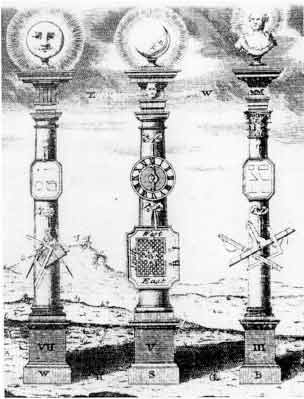 |
Fig 2
In The Constitutions of the Freemasons (1723), James Anderson
identifies the history of speculative Freemasonry with an ideological
interpretation of the history of Architecture. According to him the "Arts of
Building" attained the highest degree of perfection under the emperor Augustus
who was the patron of Vitruvius. Then after the dark period of the Middle Ages
one began "...to discover the Confusion and Improperty of the Gothic Buildings,
and in the Fifteenth and Sixtheenth Century the AUGUSTAN STYLE was raised from
its rubbish in Italy...". Among all the architects of the Renaissance the
importance of Palladio and Inigo Jones is stressed: "...above all the Great
Palladio who has not been duly imitated in Italy though justly rivaled in
England by our great Master-Mason Inigo Jones..." (23)
James Anderson is an
important figure since his book The Constitutions of the Freemasons,
Containing the History, Charges, Regulations of that Most Ancient and Right
Worshipful Fraternity. For the use of the Lodges (1722)—in which he reported
the history of the society and the Charges and regulations of masonic
conduct—remained the major source of masonic ideology throughout the world.
Anderson referred to the "Old Charges" but he modernised them.
As far as religion is concerned, he wrote that freemasons had to believe in
the "Religion in which all Men agree"—that is, in a Universal Religion or the
Religion of Nature (24). The essence of this Natural Religion was based upon the
belief in a Supreme Principle Creator and in the understanding of the moral law.
In all freemasonic documents we find the expression: "In the name of the
almighty Creator of the world". Thus modern Freemasonry was a religious
fraternity, where freemasons as individuals could profess any creed except
atheism. This opened the way for the admission of members with different
religious belief and heterodox ideas resulting in an organization that takes no
position regarding creeds or religious beliefs beyond requiring that candidates
believe in one supreme Being (25). As increasing numbers of men reacting against
the bitter religious conflicts of the mid-century moved towards deism or
pantheism, masonic lodges in which by tradition doctrinal religion had no part
could not fail to seem attractive. John Toland, one of the leading figures of
the radical thinkers of the Enlightenment is known to have belonged to a masonic
society (26).
Modern Freemasonry placed itself outside public society and thus it was
independent and indifferent to governments policies. The charge which refers to
politics reveals this attitude in a subtle, diplomatic way:
A Mason is a peaceable Subject to the Civil Powers, wherever he resides or
works, and is never to be concern'd in Plots and Conspirancies against the Peace
and Welfare of the Nation....if a Brother should be a Rebel against the state,
he is not to be countenanc'd in his Rebellion, however he may be pitied as
unhappy Man; and, if convicted of no other Crime, though the loyal Brotherhood
must and ought to disown his Rebellion, and give no Umbrage or Ground of
political Jealousy to the Government for the time being; they cannot expel him
from the Lodge, and his Relation to it remains indefeasible
(27).
A freemason could plot against the state without risking being expelled from
the Craft. Freemasons wanted to avoid conflict with the government but at the
same time did not support government policy. The lodge sought to make a better
society through the virtue of each brother practised within a constitutional.
setting derived from British political tradition. The eighteenth-century British
masons attempted to recreate the order, civility and harmony they imagined to
have been embodied in the practices of the ancient constitutional government
enshrined in the Revolution Settlement of 1689. Freemasonry encouraged
fraternity and equality, as seen in the following passage:
The whole world is but one great republic, of which every nation is a family
and every particular person is a child. To revive and spread abroad those
ancient maxims drawn from the nature of man, is one of the ends of our
establishment. We wish to unite all men of an agreeable humour and enlightened
understanding, not only by the love of the polite arts but still more by the
great principles of virtue; and from such a union, the interest of the
fraternity becomes that of all mankind (28).
These utopian sentiments could justify demands for concrete reforms, for the
translation of those private masonic ideals into public action: the abolition of
privileges and corruption and the institution of true fraternity and equality
for all men. However moderate and nonconspiratorial it may have been, its belief
in civic duty, virtue and the progress of human betterment gradually turned
against traditional privileges and established hierarchical authority and
prepared the soil for the late eighteenth century democratic revolutions in
Europe. Politicians feared that it could supply the focus for any potential
revolt against them since its utopian ideals and its rules ( the Charge on
government and politics) allowed it without admitting it clearly. This was one
reason why princes, kings and politicians of the eighteenth century wanted to
participate in Freemasonry and be on good terms with it. Walpole is a typical
example of somebody who became a mason in order to secure his position in the
government. Being a freemason allowed him to keep check on the radical fringe of
the Whig party (29) and on his opponents and to reinforce useful international
political alliances (30).
This introduces the problem of the position of British freemasons within the
political context of the century governed by Walpole. With the election of
Robert Walpole as Finance Minister in 1721 politics were stable but the
stability rested on the systematic corruption of the Parliament by the
executive. Walpole knew how to manoeuvre his rivals and was able to raise his
position from Finance Minister to Prime Minister. He enjoyed the full confidence
of the king and had the control of the Crown's extensive patronage. He dominated
the political life of his time because he was able to control the members of
political society in a network of patronage and influence by awarding government
positions and pensions to his supporters in Parliament. By doing so he brought
the institutions of government into grave disrepute. This lax political
pragmatism proved that one of the most important Whig beliefs on the moral
qualities necessary to preserve a free government was no longer respected and
this was seen as a threat to the foundations of England's liberty-preserving
"mixed" constitution (31).
The development of this separation between power and morality, political
reality of the time and ideal socio-political concepts of the English Revolution
legacy brought about a gradual dissolution of the old party division as well as
the development of a strengthened Parlamentary Opposition party composed of
discontented Whigs and reformed Tories (32). By 1711 Shaftesbury had to admit
that after 1688 Whigs and Tories could no longer be identified with distinct
social classes, because also a: " ..noted friend to Liberty in Church and State
an Abhorror of the slavish dependancy on Courts " when in possession of power
can, despite his principles, become a " Royal Flatterer, a Courtier against his
Nature... (33)." Commonwealthmen like John Trenchard and Thomas Gordon expressed
the same conviction in one of their Cato's Letters (1724):
A Tory under oppression or out of Place, is a Whig, and a Whig with Power to
oppress, is a Tory (34).
Therefore during the Georgian period the old party division became more a
division between the Court party (the party in power) and the Country party, as
the Opposition was defined (35). Many people involved in the new experiments of
garden design belonged to this Country party
(36). Linda Colley, in her study on
the Tory party from 1714 to 1760, argues that the Tories simply modified their
attitude to meet changing circumstances but preserved their ideological identity
despite the necessary alliances with Dissident Whigs. She concludes that a
neutral and ideologically homogeneous Country party never existed
(37). It is
certainly true that in the early Hanoverian period it proved very difficult to
organize an effective opposition with a distinctive ideology and coherent
policy. The different elements making up the Country Opposition could not agree,
for example, about matters of religion or about who should enjoy active
political power. Nevertheless, none of the various element of the opposition
wished to overturn the constitution. The radical Whigs, described as Commonwealthmen or classical republicans, were not democrats or opponents to the
monarchy. The opposition Tories, for their own part, gradually severed all links
with Jacobism and reconciled themselves to both the Revolution settlement and
the Hanoverian succession. It was the fear of corruption, more than anything
else, which united the disparate elements into an ideologically motivated
opposition to the political methods adopted by the establishment Whigs
(38). Their campaign was as much moral as it was political. They all agreed on an
ethic of civic virtue which maintained that society and civil government could
only be preserved by the patriotic action and public spirit of man of property.
However , the 'ideal' national regeneration they were longing for, was
conceived, within a merely utopian framework, as their aim was ( at least at
this first stage 1722-1760): " to effect a confrontation of the actual world of
Augustan England with a country of the mind (39)."
Therefore, the secret masonic society may have represented the ideal,
virtuous, liberal society that the Country party was longing for. It provided an
ethical system that emphasized fraternity, friendship and equality as well as
the value of liberty. These values were much praised by the Opposition: Lord
Cobham erected the Temple of Friendship at Stowe, and here he used to meet his
circle of friends, namely those on the side of the patriotic Opposition. This
same building was later named the Temple of Liberty in order to express the main
belief of those people whom he met there. Freemasonry could also furnish a
sufficiently broad religiosity of its memebers to accomodate both the Christian
and the heterodox or the anticlerical, and the Opposition was composed both by
catholics like Pope and anticlericals like the radical Whigs. Moreover, the
masonic emphasis on order, morality, virtue, fraternity and tolerance, naturally
put freemasons on the side of the virtuous "country" ideals as opposed to the
"court," which in Walpole's era stood for decadence and corruption.
Nevertheless the constitutional order that permitted men to even imagine such
perfect civil society was appropriated after 1689 by a landed and commercial
oligarchy that identified itself with the court. Eighteenth century British
freemasons were caught in a cultural and rhetorical dilemma. They identified
with the ideals of the country, but their leadership lived, for the most part,
like the court. As a result the lodges never posed a threat to the state. Yet
Freemasonry was perceived as a potentially dangerous institution and could house
a variety of radical thinkers or people with oppositional political
perspectives. Some of these radical Whigs, (40)
disillusioned with the outcome
of the Revolution of 1688-9 at home, ventured across the channel to seek
followers and they found them in the Netherlands (41).
These freemasons from the
early eighteenth century onward brought their discontent with the
post-revolutionary order in England to the Continent and exported into northern
Europe an institution that could provide a social nexus for displaced idealists,
political agents and subversive thinkers (42).
This republican coterie safely
tucked away in the Hague was also well connected with the opposition Country
party in England (43).
Freemasonry and Garden Architecture
What stands out from this account of Freemasonry is that the importance of
the role played by this secret society within the context of the Enlightenment
thought was an important one and must be taken into account when considering
this historical period. It is significant that all these whom we have noted as
influential in the creation of the landscape garden had strong connections with
Freemasonry (44).As we have seen this secret society corresponded to a utopian
world where they could freely express their virtuous "country" ideals. Having
established this, we need now to discuss whether we can detect in the
architecture of their gardens any reference to freemasonic ideas. We have
discussed above how the Vitruvian concept of the architect and the importance of
architecture as a culmination of all other studies and therefore superior to
them, reached England in the sixteenth century and at about the same time it
became a fundamental concept of Freemasonry. Together with this Renaissance
concept of the architect as the master of all the arts central to human
knowledge, the other Vitruvian concept, followed by Renaissance architects like
Alberti and Palladio, which became a basic ideal of Freemasonry since the
seventeenth century, was the dialectic between Architecture and Morality.
The reconstruction of the Solomonic Temple in freemasonic thought,
represented both the intention to imitate the rules of a "divine" architecture
and to apply the natural laws of proportion and balance as part of the search
for an individual and common purification. The Temple was the greatest
achievement of Architecture in ancient society, and so the preliminaries to a
purification of society and a reconstruction of the last values of that ancient
society were achievable by reconstructing the Temple. The Temple became a moral
edifice as an example of what was noble and splendid and true in the first ages
of the world. In eighteenth century England, Shaftesbury - who most probably was
a freemason (45) (Fig. 3) - revived this concept of the moral function of art
applying to the Neoplatonic concept of architecture as the first manifestation
of the cosmic order, his Moral philosophy of the "beautiful balanced soul" thus
asserting the correspondence between the harmony of the soul and the harmony of
Architecture (46). As a result, architecture becomes expression of the "Inner
Beauty" that is the Morality and Virtue of his creator: "..The beauty and effect
of their art consists in representing moral truth (inward numbers) by means of
harmonious symbols (outward numbers) (47)."
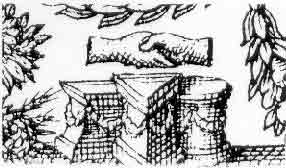 |
Freemasonic emblem from Shaftesbury ‘s
Characteristics of Manners, Opinions, Times, London, 1724. The Royal
Art of Freemasonry is represented by a brotherly shake of hands over an
altar composed of the three geometrical figures of the square, circle and
triangle. |
Fig 3.
Shaftesbury 's dialectic between Architecture and Morality and his idea of
the "wise man" who following moral behaviour becomes the "Architect of his own
life" corresponds to the idea of the reconstruction of an internal moral Temple
that each freemason with his behaviour endeavoured to reconstruct.
The purpose of masonic initiation was to lead the probationer to knowledge
through inner enlightenment. During the initiation he was transformed
symbolically into Hiram, the legendary builder of the Temple. Thus it was not an
external Temple that had to be built, but an internal invisible one. It was the
life and soul of men that had to be the building material of the "Royal Art".
This temple was usually represented in the Renaissance with a circular shape
similar to the Pantheon. In 1554 Jean de Tournes in the illustrations of the
Bible of Condé (Fig. 4) represented the temple as a "rotunda" with a dome like
Von Heemkerk in 1557. In Martin Von Heemkerk's engraving (Fig. 5) of the Temple
the two pillars Joachim and Boaz are also represented. (These two pillars
signified the entrance to the Temple-Lodge not only as a memory of the Temple of
Jerusalem but also as reminder of the seeking, finding and keeping of lost
wisdom). Thus Pantheon-like structures found their way into Masonic design as
the exemplum of the Solomonic Temple with all its symbolic and allusory
properties.(Fig. 6)
Fig 4
Anonymous, The Construction of the Temple of Solomon
XVI c. Xilography from the Bible de Condé, c.1600.
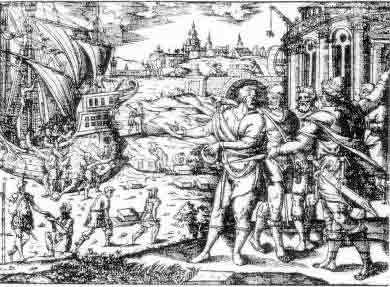 |
Fig 5
Martin Van Heemskerk’s version of the destruction of
the Temple of Solomon in Jerusalem, in an engraving by Philip Galle,
Bild-Archiv der Österreichischen Nationalbibliotek, Vienna.
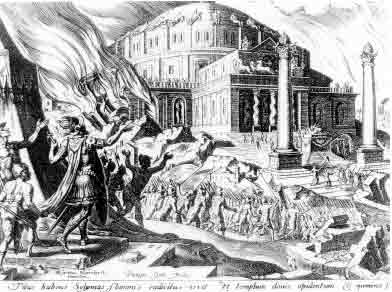 |
Fig 6
Engraving from Le Régulateur du Maçon of 1801
showing a pantheon structure on a base of seven steps, with G in glazing star.
Mason tools. A beehive, the seven stars, sun and moon, and pyramid on
cube
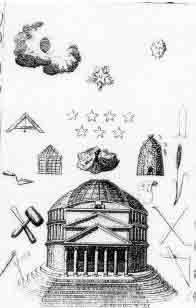 |
The circular building was also for Palladio the best representation of
classical architecture and in his Quattro Libri he refers with admiration
to Bramante's round temple of S. Pietro Montorio in Rome (48). We know that Palladio had been fascinated by this structure, since he copied drawings of
Roman Mausolea like the Mausoleum of Romulus and the Temple of Palestrina and
realized his ideal villa (La Rotonda) as a centralized Temple-like form
(49).
The eighteenth century conception of Palladio's Rotonda as the building which
best represents the relationship between Palladio and the ancients can also be
detected in the "Capriccio con la Rotonda" painted by Canaletto during his
journey to England (1750-55) (50). In this Capriccio, the Rotonda is painted
with a structure similar to the Pantheon, thus stressing the link between
Palladio and its classical sources. (Fig. 7)
Fig 7
Canaletto, Capriccio con Rotonda, oil on canvas, 81.5
x 115.5 cm. Private collection, Rome
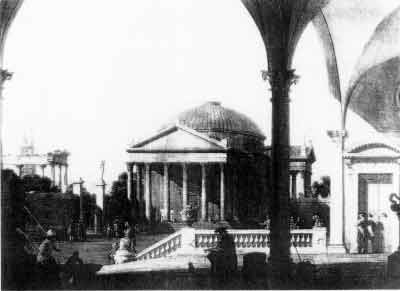 |
It is no surprise then if the eighteenth century English connoisseurs chose
the temple-like building- exemplified in the Rotonda - as the best
representation of Palladian classical architecture, probably attributing to it
(since they were freemasons) the masonic and allusory properties discussed
above. If we consider the influence of Palladio on the most important promoter
of English Palladianism, Lord Burlington, we can realize how the Earl was
especially interested in reviving the classical purity of Palladio and his
famous villa at Chiswick can be considered as an anticipation of the neo-classic
style (51). If we compare Chiswick villa (1726-9) with one of its main sources
Palladio's Villa Capra (La Rotonda 1570) we see how the Roman character prevails
in the former (Fig.8-9). The octagonal dome hall and the thermal windows derive
from the drawings of Roman baths which Burlington bought in Italy in 1730
(52).(Fig.10). The ceiling of the Gallery apses and the octagonal dome are
coffered somewhat along the lines of the Palladian illustration of the Temple of
Venus in Rome (53).(Fig.11-12). At Chiswick these Roman ceiling features are
unparalleled in grandeur and variety of forms in spite of the minuteness of the
building scale. The dimensions of the house have always been a mystery to the
point of wondering if Chiswick is more a garden with a villa or a villa with a
garden (54). The interpretation of a garden with a villa is strengthened by the
Jane Clarke's latest research on the villa's possible significance as a masonic
temple (55).
Fig 8
Chiswick Villa., London, Entrance front.
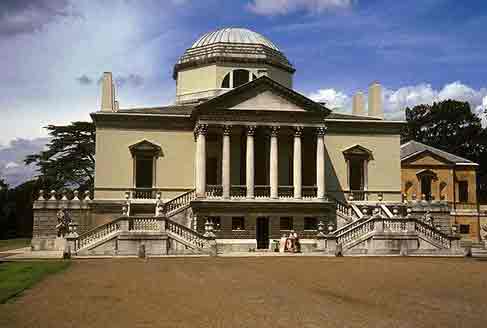 |
Fig 9
Palladio Villa Almerico or Rotonda, Vicenza, begun in
1565/66.
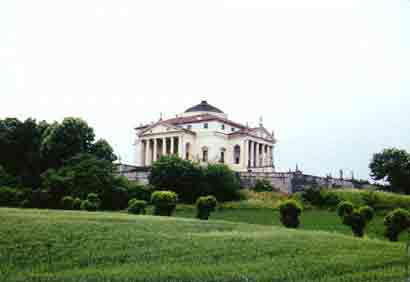 |
Fig 10
Chiswick Villa. The garden front.
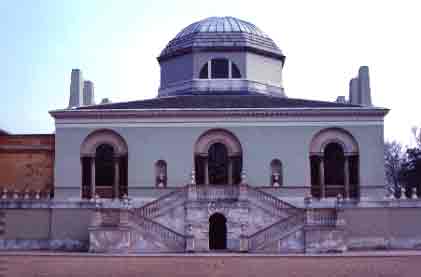 |
Fig 11
The apse at the east end of the Gallery, Chiswick
House ( English Heritage).
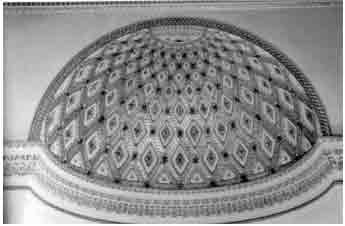 |
Fig 12
Illustration by Andrea Palladio of the interior of
the Temple of Venus in Rome, from the Quattro libri, Book IV., Venice ,
1570
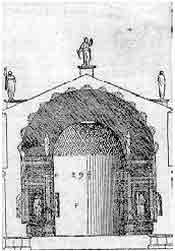 |
In the garden, the link with Freemasonry is also reinforced by the presence
of two sphinxes on the gatepiers (Fig. 13) and a miniature Pantheon with an
obelisk on a circular pond standing in front of it .It was generally believed
that the prototypes of initiatory architecture were Egyptian (Fig. 14-15), as
Egypt was the home of Hermetic magic developed by the Egyptian priests who
venerated Hermes Trismegistus, first Magus
(56). In the same way the presence of
pyramids and pyramid-like forms in the early English landscape gardens like Cirencester, Castle Howard, Stowe, Rousham, Studley Royal, Castle Hill, at such
an early stage - well before the later eighteenth century archaeological
explorations of ancient civilisations - could be understood as an expression of
masonic ideals of the garden's owner.
Fig 13
Statue of a sphinx at Chiswick (English
Heritage).
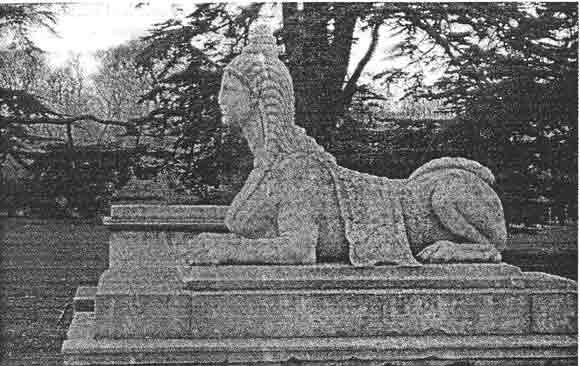 |
Fig 14
Shinkel’s design for act II of Die Zauberflöte (
Mozart ) in the 1816 Berlin production, Shinkel Museum SM XXII c/102. In this
masonic play by Mozart, the Egyptian architecture was amply used. Deutsches
Theatermuseum, Munich.
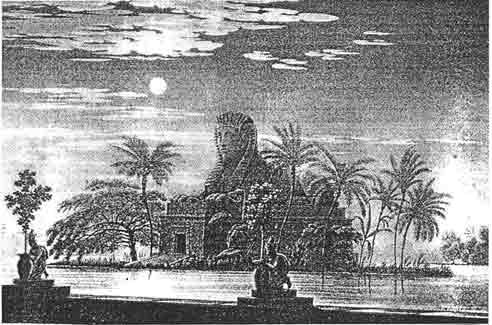 |
Fig 15
A design for a Masonic certificate for Lodges under
the Grand Orient of France, from a nineteenth-century printer’s sample book.
Note the pyramids, palm trees, Masonic tools, Egyptian architecture. Note the
rock-work cavern on the left.
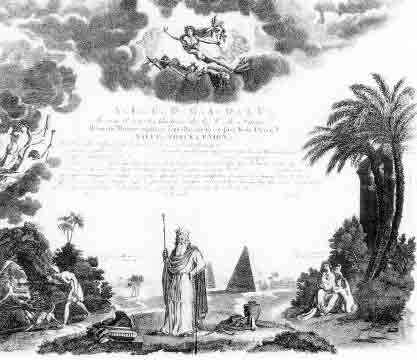 |
Pope's preference for pyramids is testified by his letter to Lord Bathurst
where he advised his friend to consider building a pyramid in his park
(57). The
English architect Hawksmoor designed the pyramid that decorates the landscape of
Castle Howard (Fig. 16). In that same garden Lord Carlisle engaged Vanbrugh to
design together with the gateway surmounted by a heavy pyramid, an obelisk
(1714) on the approach road to Castle Howard (Fig. 17-18). The fact that the
obelisk was intended as a reference to Egypt—though it was amply favoured by the
Romans as funerary architecture—is clear by the following letter written in 1742
by Pope (who erected an obelisk in his own garden), where he advised his friend
Martha Blount to build an obelisk in her garden at Sherbourne Park in Dorset in
honour to the family of Lord Digby:
I would sett up at the entrance of'em an Obelisk, with an inscription of the
Fact: which would be a Monument erected to the very ruins; as the adorning &
beautifying them in the manner I have been imagining, would not be unlike the
Egyptian Finery of bestowing Ornament and curiosity on dead bodies
(58).
Fig 16
Castle Howard. Pyramid by Vanbrugh
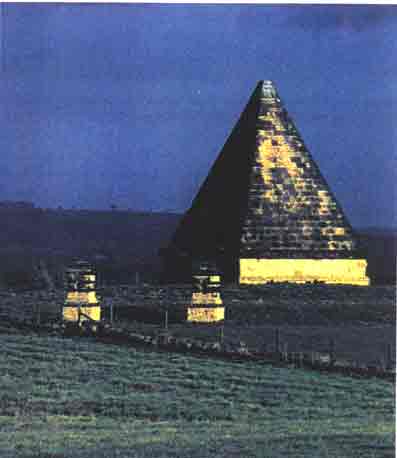 |
Fig 17
Castle Howard, Obelisk
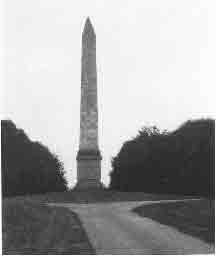 |
Fig 18
Castle Howard Entrance gateway by Vanbrugh
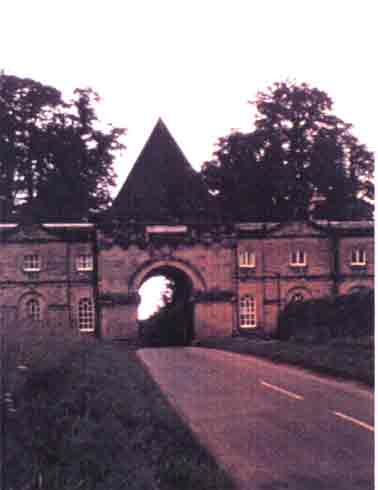 |
The obelisks in freemasonic symbolism were associated with the sun and
mythologized astronomical phenomena. They were symbols of continuity, power,
stability, resurrection and immortality. At Stourhead this symbolism of the
obelisk was reinforced by a copper sun or"mythra" which surmounted it. The proof
of its existence is given by a poem published in the December issue (1748) of
The Gentleman's Magazine and by a report given in 1755 by James Hanway
which described the obelisk as one hundred feet tall and situated on the highest
point at the end of the terrace called Fir Walk
(59). An obelisk, situated at
the centre of an octagonal pool (Fig. 19), was also present at Stowe (dismantled
in 1759) together with a pyramid sixty feet high (Fig. 20) which was probably
the last building conceived for Stowe by Vanbrugh. It was already in place in
1724 when Viscount Perceval visited Stowe : "The Pyramid at the End of one of
the walks is a copy in miniature of the most famous one in Egypt, and the only
thing of its kind I think in England (60)."
Fig 19
Stowe. Rigaud, "View of the Great Basin, from the
Entrance of the Great Walk to the House." Ink and Wash. 1733-34 Metropolitan
Museum of Art, New York,, Harris Brisbane Dick Fund, 1942.
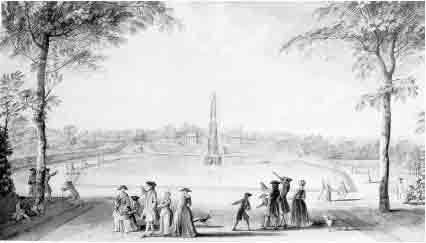 |
Fig 20
Stowe. Rigaud, "View from the foot of the Pyramid."
Ink and Wash 1733-34 Metropolitan Museum of Art, New York, Harris Brisbane
Dick Fund, 1942.
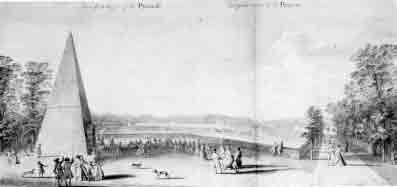 |
William Kent, was probably aware of the meanings associated with the obelisk
and the pyramidal form, since, not only did he design an obelisk for Thomas
Coke's country estate at Holkham Hall, he also placed a stepped pyramid over the
central block of his Temple of British Worthies at Stowe (Fig. 21). Within the
oval niche of the aforementioned pyramid was set a bust of Mercury. Mercury was
an important figure for freemasons as his Greek name was Hermes, the messenger
of the Gods, the herald and keeper of mysteries and also the god of trial and
initiation. He was called Trismegistus, the Thrice-Greatest Hermes who was
identified with Euclid (and hence with Pythagoras) and after whom Hermetic (or
Egyptian) wisdom was named (61).
Fig 21
Stowe, Temple of British Worthies
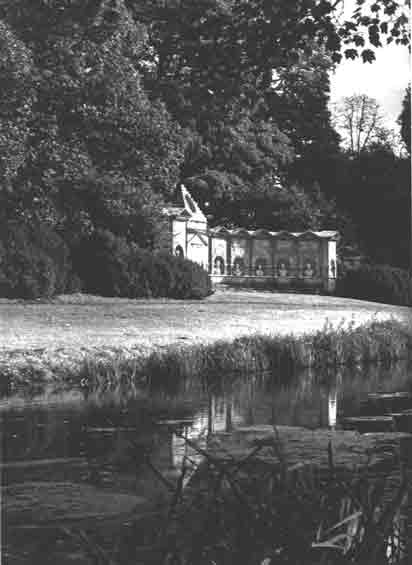 |
At Rousham, according to MacClary's letter (1750), a pyramid building was
also erected in the garden in 1738/39, while in the Praeneste the presence of a
statue of Mercury/Hermes is mentioned. This mythological figure is also present
at Chiswick House. As explained by Jane Clarke, the ceiling painting in the Red
Velvet Room portrays the resurrection of the arts by Hermes/Mercury. The masonic
symbols of mallet, compass and square are all present. The painting is dominated
by Hermes accompanied by two putti, one holding a jewel and one a cornucopia,
another masonic symbol. The central panel of the ceiling is surrounded by other
signs of the zodiac with their Gods. The study of the stars was an important
aspect of Hermetic philosophy and key to secret knowledge
(62). The signs of the
Zodiac adorn the ceiling of many a lodge and this supports Clarke's thesis of
the use of Chiswick House as a masonic temple. What may also be interesting is
the fact that Burlington based the Assembly Room at York on Palladio's Egyptian
Hall and the lodge at Edinburgh and Dublin, to mention but two, are Egyptian
Halls.
Furthermore, as mentioned above, Burlington's miniature Pantheon and its
obelisk in circular space, also bear a masonic message (Fig. 22). Coustos
explained the masonic symbol of the point within a circle: "the Compass being
placed with one of its points on the ground cannot fail in the correctness of
the circle which the other point describes, thus also the Master should
circumscribe his actions so they be without fault, and thus complying set a good
example to others (63)." An engraving of Claremont, recently discussed by John
Harris and which he dated to the period of Newcastle's patronage of Kent, shows
a miniature domed pantheon-like temple (unexecuted) with a four column portico
on the top of the garden amphitheatre (64). Similarly to Chiswick, in the centre
of the circular pond in front of the Pantheon, was set an obelisk. (Fig. 23) The
same pantheon-like building with an obelisk in front of it is shown on the first
page of a Masonic song-book published in Berlin. (Fig. 24) and appeared in a
text vignette in in Shaftesbury's Characteristik of Men.. (1714) where it
was shown as "Templum felicitatis" (Fig. 25).
Fig 22
Chiswick,"Ionic Temple and Orangery," painting by
P.A. Rysbrack, c.1729, Devonshire Collection, Chatsworth.
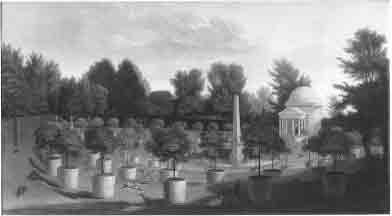 |
Fig 23
The amphitheatre and circular pond at Claremont by an
unknown English artist and engraver. Engraving. King’s maps, British
Library.
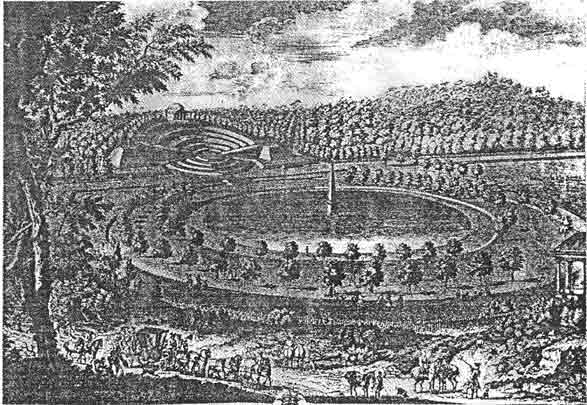 |
Fig 24
Masonic song-book, Berlin 1798, first page. United
Grand Lodge of England (UGLE), London.
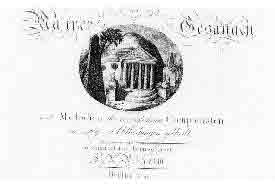 |
Fig 25
Emblem of the Templum Felicitatis from Shaftesbury’s
Characteristics of Manners, Opinions, Times, London, 1724
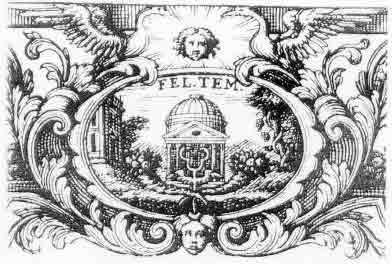 |
This tradition appears to have been continued later in the century when
neo-classical architects took on what had been established in England before
1750. James Curl has demonstrated that the neo-classicist fascination for
Pantheon-like forms combined with pyramids, obelisks and blank walls derived
from Piranesi's visions of real buildings of Antiquity, had strong links with
Freemasonry (65). Essentially his argument is that the key figures of the
neo-classicism were freemasons and they were inspired by masonic symbolism. The
same argument could hold true for the revival of Palladianism since this
movement was exported to the Continent and to America, through the Lodges, as a
first stage of neo-classicism: Algarotti, Fredrich II, Lodoli's circle, Laugier,
Ledoux, Boullée and some of the revolution architects were famous promoters of a
classical Neo-Palladianism and prominent freemasons
(66). The Rotonda as villa
temple, for example, became the model of neo-classical French architects like
the freemason Ledoux (67). (Fig. 26)
Fig 26
C.N. Ledoux, Vue perspective du Palais Episcopal de
Sisteron, in Architecture de Ledoux, Paris 1847, Vol.I, pl.194. One of the
several Ledoux buildings which derive from la Rotonda.
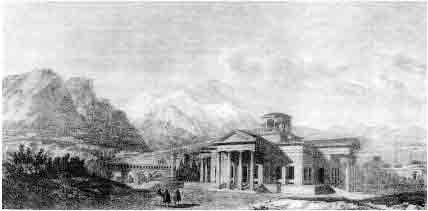 |
It may be asserted therefore that the eighteenth century enlightened English
élite looked at Palladio in search of its classicism because this reflected the
order and simplicity of the ancient civilisations who derived their
architectural rules from the Temple of Solomon. After all this we can suggest
that the presence in the landscape garden of round temples (Temple in the Wood
at Holkham Hall (Fig.27), Temple of Ancient Virtue and Temple of Friendship at
Stowe (Fig. 28-29) , Mausoleum at Castle Howard (Fig.30), Temple of Apollo at
Stourhead (Fig. 31) Rotunda at Hagley Hall, Doric Temple at Rousham) rotunda
like buildings (Temple of Four Winds at Castle Howard) (Fig. 32) and
Pantheon-like building ( Stourhead, Chiswick) (Fig. 33) could - not only refer
to Gaspard or Poussin paintings - but also to the round form of the Solomonic
Temple, the prime model from which Vitruvian Classical Architecture derived. The
creators of those gardens, most of whom were freemasons, certainly knew that
this kind of building had potent symbolic visual properties. We know that Ralph
Allen's architect John Wood, when planning the park chapel for the garden at
Prior Park, made an explicit reference to the Solomonic Temple as he wrote he
would build the chapel : " in the manner in which King Solomon finished the
inside of this Temple of Jerusalem" (68). This masonic interpretation would add
to the richness of the referents, since the round temple already existed in
antiquity, was taken up by Bramante, and in its plan and section represented a
model of the perfection of the universe which is probably another reason why
freemasons, who were concerned with the perfectibility of the people, took it as
the ultimate model of architecture.
Fig 27
Holkham hall, Kent’s Temple in the Wood
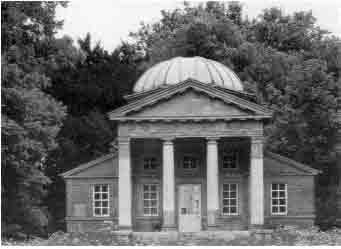 |
Fig 28
Stowe, Temple of Ancient Virtue
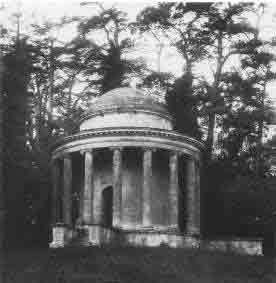 |
Fig29
Stowe, Temple of Friendship
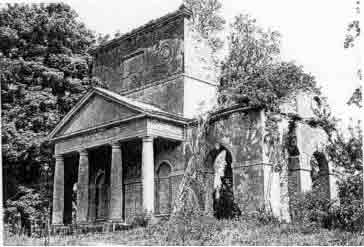 |
Fig 30
Castle Howard, Mausoleum designed by Hawksmoor.
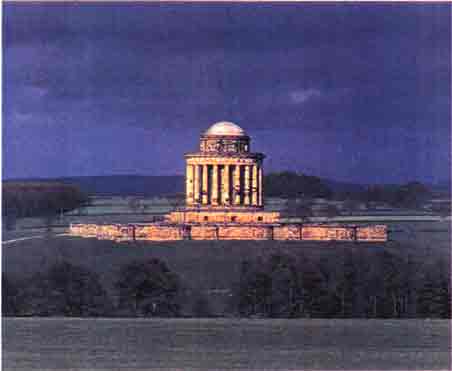 |
Fig 31
Temple of Apollo at Stourhead
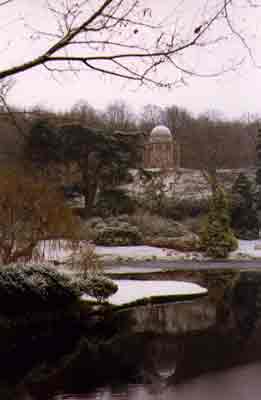 |
Fig 32
Castle Howard. Temple of the Four Winds by John Vanbrugh.
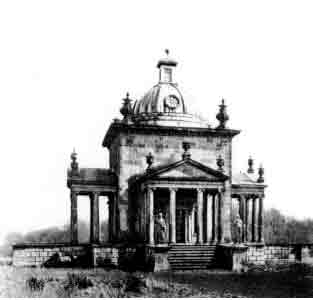 |
Fig 33
Stourhead, Pantheon
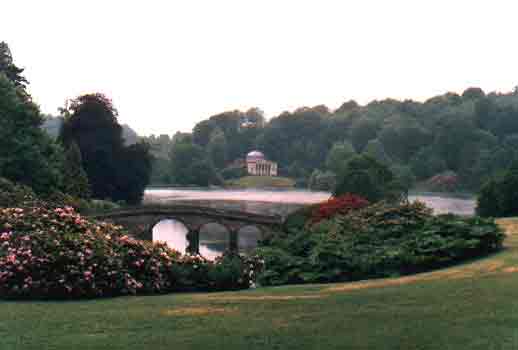 |
FOOTNOTES
(1) See Patrizia Granziera, The Ideology of the English Landscape Garden
1720-1750, unpublished PhD thesis, University of Warwick, 1997. See also
Christopher McIntosh, "Gardens of Initiation: Horticulture, Esoteric Symbolism,
and the Spirit of Play," in R. Caron, J. Godwin et al., eds., Ésotérisme,
Gnoses, and Imaginaire Symbolique: Mélanges offerts à Antoine Faivre,
(Leuven: Peeters, 2001): 625-638.

(2) These lodges took their names from London pubs (The Goose and Gridiron
Ale-House in St. Paul's Churchyard; Crown Ale-House in Parker's Lane, Apple-Tree
Tavern in Charles-Street, Covent Garden; Rummer and Grapes Tavern in Charles
Row, Westminster). Douglas Knoop, G.P Jones., The Genesis of Freemasonry,
Manchester, 1949, pp.159-163.
(3) The Old Charges are preserved in at least 115 documents, of these some
ninety exist in manuscript, ten have survived only in print, some fifteen are
missing.
(4) A.G. Mackey, "Gli antichi manoscritti", Rivista Massonica, 68,
1977, pp .271-274.
(5) Douglas Knoop, op. cit, pp. 62-72.
(6) Bernard Fay, La franc- maçonerie, Paris, 1935, pp. 182-185.
(7) Knoop, op. cit., pp. 67-69.
(8) Their titles are: Allgemeine und general Reformation der gantzen
weiten Welt. Beneben der Fama Fraternitatis dess löblichen Orders des
Rosenkreutzes, an alle Gelehrte und Häupter Europas geschrieben e Fama
Fraternitatis. Beneben Confession oder Bekantniss derselben Fraternitet, an alle
Gelehrte und Häupter in Europa gescrieben. C. Francovich, Storia della
massoneria in Italia dalle Origini alla Rivoluzione Francese,
Firenze, 1975, p. 5.
(9) Yates, F. A The Rosicrucian Enlightenment, London, Routledge and
Kegan Paul 1972, pp. 67-70. Yates explains that the Rosicrucian manifestos were
connected to Frederick V and contained political and religous allusions to the
time when Frederick, head of the union of German Protestant princes, tried to
conquer Bohemia and take the place of the Catholic king Ferdinand of Habsburg.
This would have been the universal reformation announced in the manifestos that
the Bohemian wanted to realize with the help of the Palatinate Elector.
(10) David Stevenson, The Origins of Freemasonry. Scotland's century
1590-1710, Cambridge, 1988, pp. 97-105.
(11) Knoop, op. cit., p. 63.

(12) Stevenson,op. cit., p. 105.
(13) Cerutti, Fusco Annarosa, Inigo Jones Vitruvius Britannicus, Jones and
Palladio nella cultura architettonica inglese 1600-1740, Rimini,
1985, pp. 9-39.
(14) F. A. Yates, Theatre of the World,, London, Routlege and Kegan
Paul, 1969, pp. 88-89. In Anderson's Constitutions of Freemasonry, 1721,
Inigo Jones is referred to as " Great Master Mason". See also A.A. I. Campagnol,
"Le costituzioni dei liberi muratori", Rivista massonica, 56, 1989, p.
187.
(15) Margot Guralnick, "The All-seeing eye", in Art and Antiques, Jan.
1988, p. 65.
(16) Ibid.
(17) Norman Mackenzie, Secret Societies., London, 1967, p. 162.
(18) Ibid.
(19) J.M. Roberts, The Mythology of Secret Societies, London, pp.
25-27.
(20) Knoop, p. 138.
(21) Batty Langley wrote in 1728 New Principles of Gardening. His book
was one of the first to be published on gardening which praised the irregularity
of gardens.
(22) Eileen Harris, "Batty Langley: A Tutor to Freemasons (1696-1751)" in
Burlington Magazine, 119, 1977, pp. 327-333.
(23) J. Anderson, The Constitutions of the Freemasons, London , 1723,
p. 37.
(24) Ibid., p. 48.
(25) Stevenson, op.cit., pp. 117-124.
(26) M.C. Jacob, The Radical Enlightenment: Pantheists, Freemasons and
Republicans, London , Allen & Unwin, 1981
(27) James Anderson, op. cit., pp. 48-49.
(28) On the design of Masonry. Delivered in the Union Lodge, Exeter,
n. 370, 1770, in Oliver, Golden Remains, Vol. 1, pp. 197-99.
(29) M.C.Jacob, op.cit., 1981, p.162.
(30) His house Houghton Hall was the scene of one lodge meeting, the
initiation in 1731 of Francis Duke of Lorraine. That initiation occurred
precisely at a time when Walpole was seeking to reinforce Austrian-English
relations, for the purpose of preventing a European war. His ambiguous behaviour
towards this secret society is also proved by the fact that he financed a
newspaper called The Freemason whose first number ( 13 November 1733)
issued a satirical article where Freemasonry was ridiculed. See A. Mellor,
Unsere Getrennten Bruder die Freimauer, Graz, 1964, pp. 116-117.
(31) Geoffrey Holmes and Daniel Szechi, The Age of Oligarchy, New
York, 1993, pp. 12-26; G. V. Bennet, "Jacobitism and the Rise of Walpole" in
McKendrick, Neil ed., Historical Perspectives in English Thought and Society
in Honour of J.H. Plumb, London, 1974, pp. 70-92; A. S. Foord, His
Majesty's Opposition 1714-1830, Oxford, 1964; William Speck, Stability
and Strife, London 1977; J. H. Plumb, England in the Eighteenth
Century, London, 1950 and Sir Robert Walpole, London 1960; Christine
Gerrard, The Patriot Opposition to Walpole: Politics, Poetry and
National Myth, 1725-1742, New York, 1994; Linda Colley, In
Defiance of Oligarchy, Cambridge, 1982.
(32) A.S. Foord, His Majesty's Opposition 1714-1830 , Oxford, 1964,
pp. 136-159.
(33) A. A. Cooper, 3rd Earl of Shaftesbury, The Moralist , London,
1711, ii, p. 170.
(34) Thomas Gordon and John Trenchard between November 1720 and July 1723
published a series of letters signed by " Cato" first in the London
Journal , later in the British Journal. These appeared with a number
of additions by Gordon as Cato's Letters, 4 Vols., London 1724.
These two writers belonged to that group of Whig neo-Harringtonians ( James
Tyrell, Andrew Fletcher, Henry Nevile, Walter Moyle, Robert Molesworth, ) who
believed in the Whig canon of ideas about political liberty and associated with
Shaftesbury's campaign at the time of the Exclusion Crisis. J.A.A.
Pocock, Politics, Language and Time, New York, 1971,
pp.115-33.
(35) H.T. Dickinson, Liberty and Property, London, 1977, pp.
121-194.
(36) The Opposition was heterogeneous, but we can say that it was composed
mainly of two groups: the reformed Tories and later those disappointed Whigs
which were often referred to as the Boy Patriots. The group of liberal Tories
had Viscount Bolingbroke, owner of Dawley Farm, as a leader. Returned from exile
in 1723 after being pardoned for complicity with the Jacobites he was forbidden
to resume his seat in the House of Lords. His associates included Lord Bathurst
( 1684-1775), the owner of Cirencester country seat and a member of the
Scribblerus club, the centre of the Tory propaganda campaign against Walpole
which was led by Swift in 1713 and which included Bolingbroke, Pope , Dr.
Arbuthnot and Edward Harley, 2nd Earl of Oxford. The latter was another Tory
who, after the Whigs' triumph, decided to sympathize with the liberal Tories. He
retired to his estate (Dawn Hall, Wimpole) to cultivate the arts and learning,
and fraternized with Pope and Swift among others. The Boy Patriots included Lord
Cobham (Stowe), Lyttleton, Allen, Pitt, the Whig architects Pembroke and
Burlington with their gardeners Bridgemen and Kent, as well as Southcote
(Worburn farm) Shenstone (Leasowe) and Dormer (Rousham). Patrizia Granziera
The Ideology of the English Landscape Garden 1720-1750 , unpublished PhD
Thesis, University of Warwick, 1997.
(37) Linda Colley, In Defiance of Oligarchy , Cambridge, 1982.
(38) H.T. Dickinson, Liberty and Property, London, 1977, pp.
121-194.
(39) Maynard, Mack, The Garden and the City: Retirement and Politics in
the Later Poetry of Pope 1731-1743 , London Oxford University Press, 1969,
p. 9.
(40) The most well known extreme Whigs were: John Toland, Matthew
Tindal,Robert Clayton, Edward Clark, Sir Robert Molesworth, William Simpson.,
Anthony Collins, John Trenchard, Thomas Gordon.
(41) M. C. Jacob, op.cit., 1981, pp. 20-24.
(42) Shaftesbury journeyed frequently to the Netherlands and was a great
friend of Benjamin Furly an English republican who maintained a salon in
Rotterdam , kept a library of heretical books and established his home as
meeting place between English republicans, Dutch dissenters, French refugees.
According to Jacob, Shaftesbury thought of his associates in the Netherlands as
the «Holland Whig Party» and endeavoured to distribute copies of Toland's
edition of Harrington's work Oceana among them. Ibid., p. 93.
(43) Bolingbroke, a promoter of the Opposition ideals, had friends among the
radicals in the Netherlands and endorsed the masonic society called «the Knight
of Jubilation» which was founded in 1710 at the Hague ( with the participation
of Toland and Anthony Collins) and whose member where mainly pantheists and
republicans. Ibid., pp. 93-94.
(44) Patrizia Granziera The Ideology of the English Landscape Garden
1720-1750 , unpublished PhD Thesis, University of Warwick, 1997,
Appendix.
(45) We know already of Shaftesbury's probable connection with a lodge
created in The Hague in 1710, whose members were mostly republicans and
pantheists. Further evidence of his membership of the fraternity is the
illustration on the first page of his work Characteristicks published in
1714: the emblems of all the arts based on mathematical and geometrical science
are here united and the "Royal Art" of Freemasonry is also represented by a
brotherly shake of hands over an altar composed of the three geometrical figures
of square, circle and triangle.
(46) Quotation from A.O. Aldridge, "Shaftesbury and the Deist Manifesto",
Transaction of the American Philosophical Society, Vol. 41, Philadelphia,
1951, p. 331.
(47) Ibid., p.339.
(48) Andrea Palladio, I Quattro Libri dell'Architettura, Venezia,
1570, Chap, XVII, p. 64.
(49) Robert Tavernor, Palladio and Palladianism, London, 1991, p.
77.
(50) W. G. Constable, Canaletto, Giovanni Antonio Canal 1697-1768, 2
Vols., Oxford 1962, II, p. 415.
(51) Richard Boyle 3rd Earl of Burlington (1694-1753), who most contributed
to the diffusion of the ancient Roman canons of architecture as formulated by
Vitruvius and practised by the apostle Palladio, was a Whig and for the first
three years of George I's reign enjoyed the height of his political success, but
when in the spring of 1733 Sir Robert Walpole brought in the Excise Bill, he
joined the Opposition with Bathurst, Chesterfield and Cobham, and like many of
the opposition members, decided to retire to the country : "At once...he ceased
to be a Whig thus forfeiting all future chances of favour. Then as though to
cast off forever his association with the capital and ministerial functions he
packed up the best of his pictures and moved them permanently to Chiswick.."
James Lees-Milne, Earls of Creation, London, 1962, p. 59; This book
provides the best all-around account of Burlington life. More recent work
includes: the exibition catalogue, Apollo and the Arts, Lord Burlington and
his Circle, ed. J. Wilton-Ely, University Gallery Nottingham, 1973; Lord
Burlington and his Circle (Papers given at a Georgian Symposium on 22nd May
1982) and Lord Burlington: Architecture, Art and Life, London, 1995 ed.
by Toby Barnard and Jane Clark.
(52) Burlington published in 1730 "Fabbriche Antiche", a first volume of a
planned two volume set, covering the unpublished reconstructions of ancient
buildings drawn by Palladio and bought by Burlington during his second Grand
Tour. The first volume concentrating mainly on Roman Baths consists of
twenty-six engraved plates. The second volume on arches, theatres and temples
never appeared. See Dana Arnold, Belov'd by Ev'ry Muse, Essays to celebrate
the tricentenary of the birth of Lord Burlington. London, 1995, p. 515.
(53) Peter Murray," Il Palladianesimo Inglese", Bollettino C.I.S.A.,
Vol. XV, 1973, pp. 307-324.
(54) Lord Harvey exclaimed on first viewing it, " House! Do you call it a
house? Why! It's too little to live in, and too long to hang to ones
watch.",quoted in Dana Arnold, op. cit., p. 32.
(55) Jane Clarke, "The Mysterious Mr. Buck", Apollo, 129, 1989, pp.
317-322. In a recent article: "Palladianism and the Divine Right of the Kings",
(Apollo, April, 1992) Jane Clark argues that Lord Burlington could have
belonged to a Jacobite lodge, thus proving the links between the revival of
Palladianism and the Jacobite ideals. As a proof of this she discusses the
masonic symbolism of Chiswick with reference to the higher degree of the Royal
Arch and the so called « Scottish or Ancient Masonry». But the Scottish Masonry
was simply a more elaborate form of masonic philosophizing, it meant all the
higher grades which were added to the three authorized by English Freemasonry ,
it did not come from Scotland and was not all a Jacobite plot, on the contrary ,
as Jacob maintains it reflected a more radical «country» idealism. The schism
between the Ancients and Moderns occurred in 1740 and was a revolt of lesser men
against betters. Brothers began to criticize the social exclusivity of some
lodges and to demand a more egalitarism. Their literature suggests more
democratic tendencies in the English world, included a dedication to virtue and
merit and more stress on the cult of Hermes and Hermetic philosophy with its
pantheistic and cabalist associations. See J. Roberts, op. cit., pp.
94-100, M.C. J. Jacob, Living the Enlightenment. Freemasonry and Politics in
Eighteenth Century Europe, New York, 1991, p. 54, 60-63; A. E. Waite, A
New Encyclopedia of Freemasonry, London, MLMXXI, p. 403.
(56) In the scenography of the masonic play Magic Flute by Mozart (1794) the
Egyptian architecture was amply used. See Jurgis Baltrustraits, Saggio sulla
leggenda della forme, Paris, 1985, p. 42-58.
(57) G. Sherburn ed., The Correspondence of Alexander Pope, Vol. 2,
Oxford, 1956, p. 517.
(58) Ibid., p. 239.
(59) The Gentleman's Magazine, 18, December 1748, p. 568; J. Hanway,
A Journal of Eight Days Journey, 2nd ed., London, 1757, I, pp.
137-38.
(60) G.B.Clarke ed., Descriptions of Lord Cobham's Gardens of Stowe,
1700-1750, Buckinghamshire Record Society, n. 26 (n.p., 1990), 16.
(61) A. E.Waite, op. cit., p. 11.
(62) Jones Bernard E. , Freemasons Book of the Royal Arch, London,
1957, p. 229.
(63) "The Trial of John Coustos by the Inquisition", Ars quatuor
Coronatorum, 65, 1954, p. 114.
(64) Thomas Pelham, Duke of Newcastle was created Master mason of the Norwich
Maid's Head Lodge in 1731 together with Philip Stanhope, Earl of Chesterfield
(Chesterfield House), J. Anderson, op. cit., p. 129.
(65) James Stevens Curl, The Art and Architecture of Freemasonry ,
London, 1991.
(66) C. Mignot, "Lettura del Palladio nel XVII secolo: una riservata
ammirazione" in Palladio e la sua eredita' nel mondo , Milano, 1980, pp.
207-213; M. Gallet and M. Mosser, "Il neo-classicismo o il vero Palladio
riscoperto", in ibid., pp.195-206; W. H. Adams, The eye of Thomas
Jefferson , Charlottesville, 1981, pp. 234-304.
(67) C.N. Ledoux, E.L. Boulleé, J.J. Lequeu and many architects working in
Paris in the 1770 and 1780 were known freemasons and in their architectural
design they utilised a vast vocabulary of Masonic or quasi-masonic emblems. See
Werner Oechslin, "Premesse all'Architettura Rivoluzionaria", Controspazio
, 1970, Gen/feb, pp.2-13; Anthony Vidler, The Writing of the Walls,
Princeton 1987, and Claude-Nicolas Ledoux, Architecture and Social
Reform at the end of the Ancien Regime, Cambridge, Mass., MIT Press,
1990.
(68) John Wood, An Essay towards a Description of Bath , Bath,
Kingsmead reprints,1749, p. 433. John Wood was a freemason, who in his
architectural treatise The Origin of Building: or the Plagiarism of the
Heathen detected (1741), derives the origins of the proportional rules and
Vitruvian orders from the Solomonic Temple.

back to top |
![]()






































